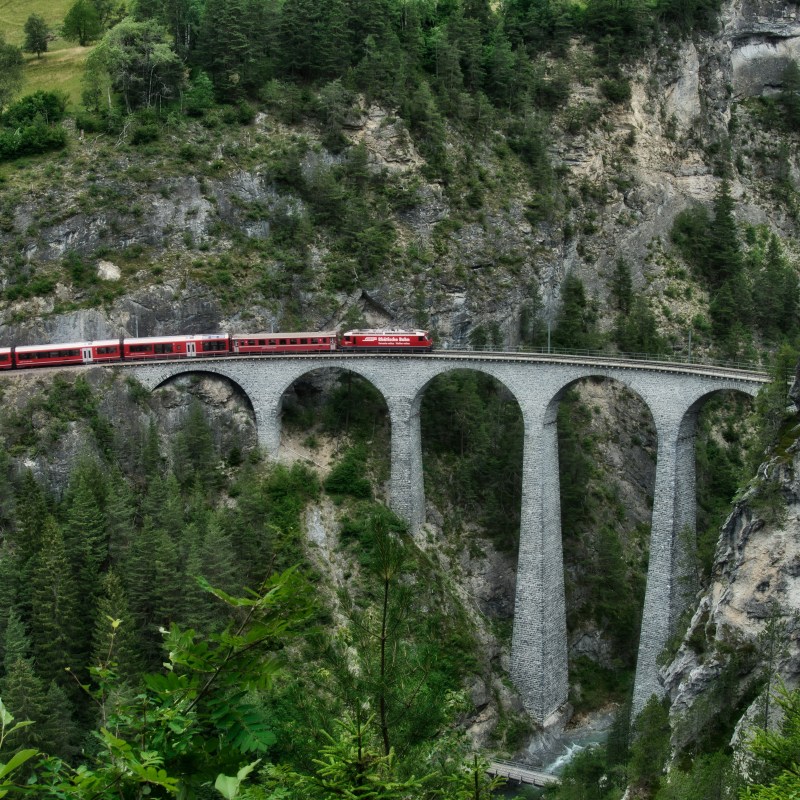
Multigenerational travel is a tricky subject.
Videos by TravelAwaits
On the one hand, family-oriented travel experts agree that multigenerational travel is one of the most impactful ways for families to bond. Even during long travel days, it’s a chance for grandkids, parents, and grandparents to exchange stories and soak up quality together time.
But planning a seamless trip can be difficult, if not maddening.
Multigenerational travel requires joint scheduling and organizing. On top of that, it’s important to find a kid-friendly destination. Plus, challenges like transportation and questions about meal-time.
Though many families dream of hitting the road together, the stars rarely align.
But what if I told you that there is a near-perfect family destination out there?
Welcome to Graubünden, Switzerland’s largest province (called a canton locally). While few Americans plan multigenerational trips to the Swiss Alps, it’s one of the great summer destinations out there.
No, it’s not too far.
And, no, it’s not too expensive.
Welcome to Graubünden
I’ve touched on Graubünden a few times when covering cool-cation spots. (More on this below.)
This canton is located in the country’s western Alpine region, bordering Austria, Italy, and Liechtenstein. You’ve probably heard of it thanks to its super-lux winter sports destination, St. Moritz.
St. Moritz aside, Graubünden is home to dozens of picturesque villages that dot the steep mountains. Chur, the canton’s capital, is one the oldest towns in Switzerland.
Its history stretches back millennia straight to the Bronze Age; over the centuries, the city served as an important stop on trade routes leading from the Mediterranean into central Europe.
In fact, many of Graubünden’s cutest little villages once offered shelter and nourishment to the thousands of merchants and traders drifting between major settlements.
So you get mountains and history galore… but that’s just the tip of the iceberg. Here’s why I think Graubünden is a great destination for multigenerational trips, starting with transportation and ending with cultural delights.
Transportation is insanely convenient
Graubünden is a large region with plenty of hidden valleys and ancient villages—but it’s not hard to get to. During a recent trip to the region, I explored multiple villages, towns, and cities… without spending more than two hours on a train.
A public train from Zurich to Chur only takes around two hours. From Chur, it’s easy to take trains or busses further into the countryside.
I’m talking public transportation that includes bus lines and trains—and even a few shuttles into smaller villages like Guarda and Ftan.
Switzerland’s public transportation schedules and routes are straightforward, and the timetables are rigid. While I can’t promise traveling with a multigenerational family will be easy, I was traveling in a group of six and didn’t face any issues using public transportation.
Kids are welcome
Traveling with kids is difficult, from surviving long plane trips to making reservations at fine dining establishments.
I was pretty floored to see such a kid-friendly atmosphere throughout Graubünden. To be blunt, I associate kid-friendly travel with bright and over-the-top cruise lines more than relaxing Alpine trips.
But there’s a welcoming approach to family time in this canton. The vast majority of restaurants and establishments are open to children. No need for shushing, no need for nervous glances. Though some spots are adult-only, most locations were built with children in mind.
For example, the National Park Centre in Zernez includes a highly interactive and engaging museum exhibit. There are two separate tours, one geared toward children and another for adults.
These types of integrated experiences allow parents and grandparents to unwind and relax at the same time, but at separate paces.
It’s not overly expensive (in summertime)
Graubunden’s high season starts in October before lulling in November and then picking back up in winter. I can’t guarantee you’ll find any deals in the canton during the colder months.
But I was surprised to learn how affordable many three and four-star hotels are during summertime. Despite the fact that summer is ‘off-season’ in the Alps, visitors really aren’t sacrificing views or natural wonders.
In fact, for people who have never skied (like me) and don’t own a winter coat (I borrow when necessary), a summer cool-cation is ideal.
The cherry on top is that even pricy and high-end hotels, like GuardaVal in Scuol or Tschuggen Grand Hotel in Arosa, drop in price. GuardaVal—which is easily one of the coolest boutique hotels I’ve explored—costs less than other three-star legacy boutique hotels in European hotspots, like Seventy Barcelona in Barcelona.
No, Graubünden isn’t cheap. But it’s also not nearly as expensive as you might assume from the Swiss Alps.
Nature, nature, nature
I’d compare Graubünden to the Rockies, but they’re simply not the same.
As I wandered around the Alps, I was reminded instead of the Himalayan foothills. The mountains are steep and close together, often rimmed with mist. (Graubünden in German translates to ‘grey leagues’.)
If you want to explore the mountains, it’s not difficult. Some ski lifts are active year-round, serving visitors throughout summer, letting you explore these giant mountains when they’re green instead of white.
All the necessary infrastructure for exploring is present, making it relatively easy to hop on a bus or train, and then take a ski lift straight into the sky.
And don’t forget about the National Park in Zernez.
Swiss culture—as you’ve never seen
Heading into Switzerland, my understanding of the country was pretty limited.
I knew that my dad’s family came from Ticino and Graubünden, that the alphorn is important, and that my euros would be no good. That’s about it.
During my trip, I was treated to many new and unexpected experiences. First and foremost, my ears were tickled by all the Romansh language. It’s similar enough to Spanish and Italian that I could piece together some words—but it also has a lot of German influence, which kept me on my toes.
I also encountered dozens of interesting sites and practices.
Scuol, which I’ve mentioned a few times in this article, is home to twenty mineral water springs. These springs have kept this town on the map, attracting people who want to heal by soaking in and drinking its mineral-laden waters.
